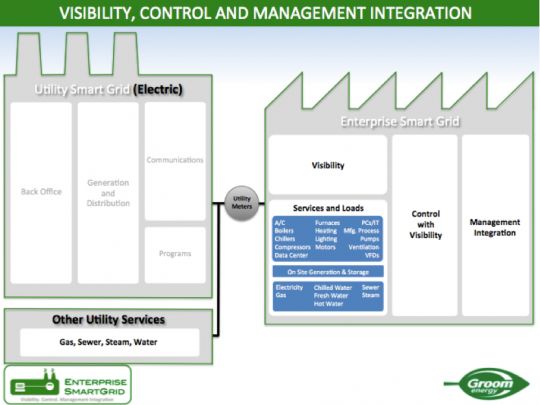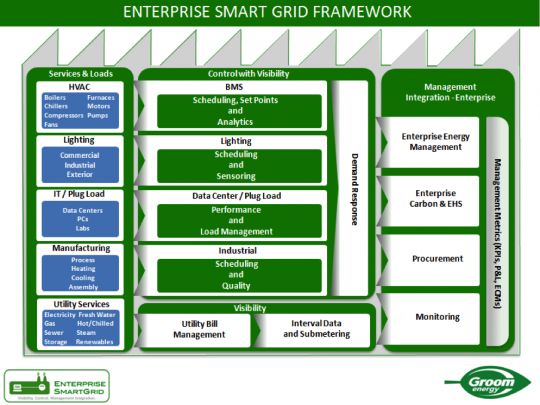This article is the first in a series of perspectives from Groom Energy that will explore the findings of GTM Research and Groom's latest smart grid market report, The Enterprise Smart Grid and a Corporate Buyer’s Guide for Energy Management Software.
Much of the current discussion about the smart grid focuses on the benefits to utilities and homes, but fails to capture the needs of large companies (or “commercial and industrial” firms, to use industry parlance). Large companies save money through better monitoring and control of energy assets within their individual facilities, not at the main utility meter. At Groom Energy, we call the application of smart grid concepts to companies the Enterprise Smart Grid (ESG), and it is a natural complement to the utility smart grid.
This article aims to provide insight into the ESG market. GTM Research and Groom Energy recently released a related report: The Enterprise Smart Grid and a Corporate Buyer’s Guide for Energy Management Software. This recent report is a complement to another GTM report: The Networked Grid 150: The End-to-End Smart Grid Vendor Ecosystem Report and Rankings.
The Utility Smart Grid
Over the last several years, much attention has been placed on developing the utility smart grid, a digital energy network, with embedded intelligence that provides reliability and efficient network operation. Smart grid technology investments have connected utilities to their customers’ main meter, giving them the capacity to see real-time consumption all the way through to the meter. The utility smart grid’s business drivers, technology architecture, and policy support focus mainly on residential customers.

Source: The Enterprise Smart Grid and a Corporate Buyer’s Guide for Energy Management Software (Groom Energy)
The Demand Side of the Smart Grid
As companies consider their need for better managing energy, they recognize they have too limited an understanding of where and when their consumption is actually occurring.
Unlike utilities, which “see” all the meters on their network as consumption points, corporations have no central view of their energy-consuming loads. Corporate loads, such as machinery, HVAC, or IT, are scattered across multiple buildings and geographies and are rarely centrally managed. Their energy demand just happens as part of their business -- they don’t proactively control or manage it.
Similar to how the utility smart grid provides a way to see and manage a high volume of residential main meter endpoints, a demand-side approach would utilize “smart metering” at a high volume of load endpoints, all integrated to a networked system. In this case, the technologies would start at the utility’s main meter and extend within the “four walls” of each location, connecting electronically to all demand-side loads, regardless of their energy type.
This system would deliver to corporations a digitally managed energy network that could be intelligently managed and balanced -- their corporate smart grid.
Such a demand-side infrastructure allows companies to address three principal business questions:
- Visibility: “Where and when is energy consumed?”
- Control: “How to control energy use?”
- Management Integration: “How can energy pricing and use be factored into capital planning and operational decisions?” and “How is energy pricing and use tied to profit and operational reports and specific manager responsibilities?”

Source: The Enterprise Smart Grid and a Corporate Buyer’s Guide for Energy Management Software (Groom Energy)
Having the capacity to answer these questions enables companies to better manage their energy consumption, but must be based on the underlying energy loads and associated utility services for each facility or operation.

Source: The Enterprise Smart Grid and a Corporate Buyer’s Guide for Energy Management Software (Groom Energy)
These underlying loads vary by industry and firm. For instance, lighting is a major load for a national retailer, whereas natural gas may be the largest load for a factory that uses industrial furnaces.
The Enterprise Smart Grid: The Definition
Enterprise Smart Grid is a system that integrates submeters, software, and hardware to provide visibility, control, and management decision tools to current energy consumption across an organization’s facilities.
Key functionalities of ESG are:
- Submeters and spot metering of the main meter and largest energy loads
- Inclusion of electric, gas, water, and steam consumption
- Energy and system control technologies
- Premise or SaaS-based energy management software
- Reconciliation of actual usage with utility invoices
- Integration to the enterprise’s profit and loss statements
- Multi-facility integration
- Understanding utility rate structure and time-of-use impact to operations
- Use of demand response programs and utility and government financial incentives
Technology is a critical enabler as companies increasingly move to more sophisticated energy management systems. An explosion of innovation and investment has increased the number and breadth of these offerings, with traditional application areas and boundaries falling. Startups are selling SaaS-based extensions to existing building management systems. Data center applications can monitor the energy load of any IP-based asset. Traditional industrial control products find applications in commercial buildings. Demand response and enterprise carbon accounting vendors have expanded offerings for energy management.

Source: The Enterprise Smart Grid and a Corporate Buyer’s Guide for Energy Management Software (Groom Energy)
The Enterprise Smart Grid has many implications for the larger industry. Utilities need to expand energy efficiency programs beyond simply lighting; driving incentives for continuous monitoring or ESG applications is the next step. Policymakers and regulators need to understand that large companies need more than a digital, wireless main utility meter. Corporate managers need to standardize a set of vendors and technologies as they increasingly implement enterprise-wide energy management programs across multiple sites.
For more information on the analysis found in The Enterprise Smart Grid and a Corporate Buyer’s Guide for Energy Management Software, visit www.gtmresearch.com.



